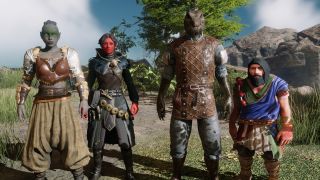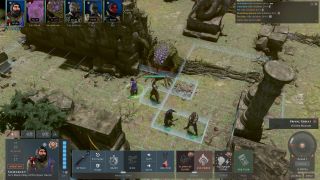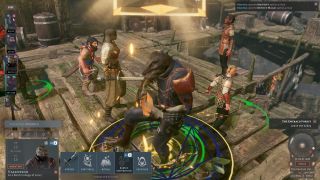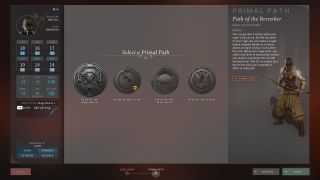Finally, an RPG let me make the weird D&D party of my dreams
Thanks to Solasta's DLC you can make a properly bizarre party at last.

Dungeons & Dragons evokes a lot of different flavors of fantasy, and there's long been tension between them. You've got the sword and sorcery stories of Conan the Barbarian, Fritz Leiber's thieves, and Jack Vance's wizards and rogues, all of which have human protagonists. But then there's the epic fantasy of The Lord of the Rings, which is full of hobbits, elves, and dwarves, as well as stories like Poul Anderson's Three Hearts and Three Lions, where a paladin goes on an adventure with a dwarf and a swanmay.
Level limits and class restrictions in some of the early editions of D&D made non-humans a bit of a hassle to play, but by the time 3rd edition arrived in the early 2000s, the typical party had a lot more options. Half-orcs were a default choice, the fiend-touched tieflings from Planescape continued being popular, and anyone could be a member of any class. That kind of diversity became even more prevalent in 5th edition, where I don't remember the last time I saw someone roll up a human. Every party seems to have some kind of bird-person, maybe a goblin, a magical construct come to life, and quite possibly a talking frog or hippo.
Unusual class choices have become normal too, with monks, warlocks, and bards as common as fighters, wizards, and clerics. The end result is that, instead of stories where relatively ordinary people travel the land gawping at odd things, D&D has become better at telling stories where the heroes bring the odd with them—where they feel like they belong in worlds full of magic and wonder rather than standing apart from them.
When it released in 2021, Solasta: Crown of the Magister was a fun distillation of D&D 5e's ruleset into videogame form. Unlike Baldur's Gate 3, which lets you design one player-character then has you recruit a party of pre-generated personalities, Solasta has you design four PCs from scratch. That lets you get your hands right into the guts of the system if you want, assigning backgrounds to avoid having multiple characters who are good at the same skills and making sure you cover all the tool proficiencies.
Though the story was nothing to write home about, Solasta's turn-based battles were memorable setpieces that took full advantage of the tabletop rules. Giant spiders attacked from the walls and vampires encased themselves in magical darkness, while you could respond with a repertoire of familiar abilities right out of the Players' Handbook. (My cleric's daylight spell suddenly became clutch when those vampires ambushed us.)
But at launch, there wasn't much variety in the type of characters you could create in Solasta—and not just because there were only a handful of voices to choose from. It was limited to humans, dwarves, halflings, elves, and half-elves, with the only classes being fighters, wizards, clerics, rogues, and rangers. Though the spells and action economy were familiar, it didn't look much like my home D&D game.

Subsequently, Solasta grew. Sorcerers were added in a free update, and the Primal Calling DLC added half-orcs, barbarians, and druids, while the Inner Strength DLC brought dragonborn, bards, monks, and warlocks. The Lost Valley expansion added more subclasses, and a new campaign.
The biggest gaming news, reviews and hardware deals
Keep up to date with the most important stories and the best deals, as picked by the PC Gamer team.
Returning to Solasta now means that, at last, I can show up to a fight with a dragonborn bard who spits shards of ice when he's not playing inspirational lute jams, a monk who can cross basically any battlefield in a single turn, a warlock who made a deal with a devil for ultimate magical power yet relies on a single cantrip, and a classic half-orc barbarian who would, yes, very much like to rage.
It's wonderful. Whenever the camera swings back to the heroes during a cutscene they look like four people who really did meet by coincidence at a pub. Though the options for voices and faces are still pretty limited, I'm happy to have chosen the goofiest head for my dragonborn, whose dangling facial tendrils droop like a sad reptilian beard.

As a bard, he dances a little twirling jig when he uses his powers, bashing out a tune on his lute or drum. It's delightful. In its own way, so is the animation for the monk's unarmed attack: a full sweeping roundhouse kick. Another post-launch addition means that everyone chants when they cast spells too, no longer waving their arms in silence. Minor things, but they make it feel right.
Not everything about Solasta is 100% rulebook, though. Since it uses D&D's Open Gaming Licence, only the most basic subclass and feat options are included, with the gaps filled by new inventions. Some of them are quite neat ideas, like warlock pacts that let you earn spells by cutting bargains with an insect hivemind, a magic tree, or a time traveler. Since part of the reason I play Solasta is to keep the 5e rules fresh in my mind for when I'm running my own game, I pretty much stick to the core options, but it's nice to have more there.
It's got some house rules too, like the inclusion of item crafting and the ditching of alignment. Given how important light and darkness are to its combat, there's a new cantrip called sparkle, and a handful of abilities have been tweaked so you can use them more often. The dragonborn's breath weapon recharges every short rest, and Path of the Berserker's frenzy, which normally causes exhaustion, lets you make a Constitution saving throw to potentially avoid that. (I've adopted that house rule in my own game to the relief of the barbarian player.)

These house rules and additions make Solasta seem even more like a campaign being run by an enthusiastic first-time Dungeon Master, which was always its vibe. It feels home-brewed and quirky, and I'm glad to be able to make a party of adventurers who feel just as quirky as the game around them. When I'm accepting a quest from a giant who demands we find a rock large enough that he can carve it into a seat and the camera cuts back to the surprised face of a dragonborn with wilted whiskers, I recognize D&D the way I play it with my friends.

Jody's first computer was a Commodore 64, so he remembers having to use a code wheel to play Pool of Radiance. A former music journalist who interviewed everyone from Giorgio Moroder to Trent Reznor, Jody also co-hosted Australia's first radio show about videogames, Zed Games. He's written for Rock Paper Shotgun, The Big Issue, GamesRadar, Zam, Glixel, Five Out of Ten Magazine, and Playboy.com, whose cheques with the bunny logo made for fun conversations at the bank. Jody's first article for PC Gamer was about the audio of Alien Isolation, published in 2015, and since then he's written about why Silent Hill belongs on PC, why Recettear: An Item Shop's Tale is the best fantasy shopkeeper tycoon game, and how weird Lost Ark can get. Jody edited PC Gamer Indie from 2017 to 2018, and he eventually lived up to his promise to play every Warhammer videogame.
Most Popular


